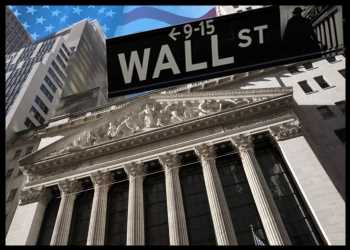U.S. Stocks Climb Well Off Worst Levels But Still Close Lower

After coming under pressure in morning trading on Thursday, stocks showed a notable recovery attempt over the course of the afternoon. The major averages climbed well off their worst levels of the day but remained in negative territory.
The Dow tumble by more than 460 points at its worst levels of the day but closed down a relatively modest 112.18 points or 0.3 percent at 33,174.07. The Nasdaq slumped 125.58 points or 1 percent to 13,129.96 and the S&P 500 fell 18.36 points or 0.4 percent to 4,259.52.
The early weakness on Wall Street reflected ongoing concerns about the Russia-Ukraine, as peace talks between the countries resulted in little progress on key issues.
After speaking with his Russian counterpart, Ukraine Foreign Minister Dmytro Kuleba said no progress had been made on Ukraine’s proposal for a 24-hour ceasefire or the establishment of a humanitarian corridor to and from the besieged city of Mariupol.
An early rebound by oil prices also weighed on the markets, but stocks began to recover as the price of crude oil pulled back off its highs and eventually ended sharply lower.
The markets have recently traded inverse to oil prices amid concerns about inflation, which were exacerbated by a report from the Labor Department showing a continued acceleration in the annual rate of U.S. consumer price growth in the month of February.
The report showed the annual rate of consumer price growth accelerated to 7.9 percent in February from 7.5 percent in January, reaching the highest rate since January 1982.
The faster year-over-year price growth came as consumer prices climbed by 0.8 percent in February after rising by 0.6 percent in January. The increase in prices matched economist estimates.
Excluding food and energy prices, core consumer prices rose by 0.5 percent in February following a 0.6 percent increase in January. The core price growth also matched expectations.
The annual rate of core consumer price growth accelerated to 6.4 percent in February from 6.0 percent in January, showing the fastest growth since August 1982.
A separate report from the Labor Department showed a modest increase in initial jobless claims in the week ended March 5th.
The report showed initial jobless claims crept up to 227,000, an increase of 11,000 from the previous week’s revised level of 216,000.
Economists had expected jobless claims to tick up to 216,000 from the 215,000 originally reported for the previous week.
Sector News
Semiconductor stocks turned in some of the market’s worst performances on the day, dragging the Philadelphia Semiconductor Index down by 2.2 percent.
Significant weakness was also visible among banking stocks, as reflected by the 1.1 percent drop by the KBW Bank Index.
On the other hand, energy stocks rebounded strongly even though the price of crude oil turned lower over the course of the session.
Reflecting the strength in the energy sector, the Philadelphia Oil Service Index spiked by 4.3 percent and the NYSE Arca Oil Index jumped by 25 percent.
Retail, steel and gold stocks also moved to the upside over the course of the session, helping offset the weakness in some other sectors.
Other Markets
In overseas trading, stock markets across the Asia-Pacific region moved substantially higher during trading on Thursday. Japan’s Nikkei 225 Index soared by 3.9 percent, while China’s Shanghai Composite Index shot up by 1.2 percent.
Meanwhile, the major European markets pulled back sharply following the rebound seen in the previous session. While the U.K.’s FTSE 100 Index slumped by 1.3 percent, the French CAC 40 Index and the German DAX Index tumbled by 2.8 percent and 2.9 percent, respectively.
In the bond market, treasuries extended the downward move seen over the past several sessions. As a result, the yield on the benchmark ten-year note, which moves opposite of its price, climbed 6.3 basis points to 2.011 percent, closing above 2 percent for the first time in almost a month.
Looking Ahead
A preliminary report on consumer sentiment in March may attract some attention on Friday, although traders are likely to pay closer attention to developments in Ukraine.
Source: Read Full Article
